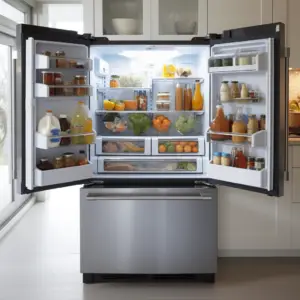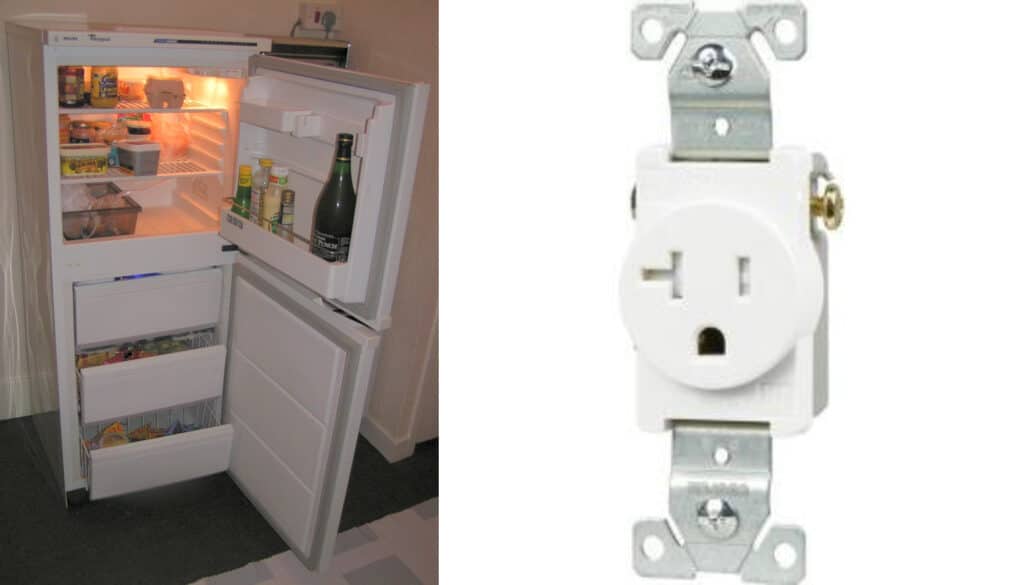Refrigerator Trips GFCI, The GFCI is your home’s first line of protection against electrical issues. It is made to trip if it detects an electrical imbalance, causing an automatic shutdown that guards against potentially harmful shock.
You understand the aggravation it can bring if you’ve ever had a refrigerator that trips its GFCI. Not only will your food perish if you don’t catch it in time, but if you don’t figure out why it’s tripping in the first place, it will keep happening. This article will discuss the typical causes of this today and solutions for stopping it from happening again.
Table of Contents
Refrigerator Trips GFCI: Troubleshoot and Diagnosis

The first step in fixing a refrigerator that keeps on tripping the GFCI should be unplugging it. These should then be followed by the steps below:
Reset the GFCI
Your first action should be to check the outlet; however, this is frequently merely a false alarm. This device can have “nuisance trips,” in which it disengages even when there is no problem with the device or power source itself.
This is because the gadget is sensitive to usage and environmental changes. You can test your refrigerator by connecting it back to the outlet, something that is mainly typical during electric hot-weather months.
The owner’s manual for your appliance should have instructions on how to test the outlet. Call an electrician to test it for you if you cannot do it yourself. Reset the GFCI after it has been tested. If the issue persists, there might be a fault that has to be fixed.
Employ a snubber
Be cautious if you use a refrigerator with vapor compression and a GFCI outlet installed close by. The fridge can trip a GFCI outlet if you unplug it.
Use a GFCI with a snubber to use their fridge or freezer. A snubber reduces appliance interference by raising ground circuit resistance. Snobbers must separate the fridge or freezer from the GFCI. Replace the box breaker with a GFCI-qualified one if you’re scared your refrigerator will trip a GFCI outlet. Changing the GFCI outlet to a standard outlet will fix the problem on a dedicated refrigerator circuit.
Examine the Power Cord
The power cord is one frequent cause of issues with refrigerators. Unplugging and carefully inspecting it are the first steps to take because the problem is typically not immediately apparent.
You can frequently notice cord damage by keeping an eye out for worn-out insulation, kinks, or bite marks. It’s time to get a new power cable if you have any of these issues with your present one.
Check the Power Plug
Examine the power prongs next. The cord has to be replaced if they are rusty or bent. Plug the appliance into the outlet and switch it on if everything seems to be in order. To check the outlet, plug in another device, such as a lamp or clock.
Overloading
If your GFCI trips frequently, you may be plugged into an overloaded circuit, which, if left unattended, might cause a fire. Before calling a professional, transfer any other large appliances or devices connected to the same circuit as your refrigerator to a different outlet.
Power Outlet Examination
Switch off the electricity at the circuit breaker. Unplug the wall outlet’s refrigerator plug. Unplug it and remove the power strip’s cover if it is plugged into a power strip.
Check the wires for any charred or blackened areas. If you notice any wire with a defect, disconnect them from the outlet and buy new ones. Reconnect the wires to the outlet before reconnecting your refrigerator.
It is simple to determine whether a power outlet has continuity. All you need to do is verify the current flow with a multimeter, and you’re ready to go!
If the outlet doesn’t have current flowing through it, one of the cables is likely to be at fault. However, ensure you have the proper tools and equipment before working on any electrical system. Also, keep in mind that you should only perform repairs if you are qualified to do so.
Circuit Breaker Problem
If you have tried all the solutions above without success, it may be time to check the circuit breaker.
Replacement or repair of the circuit breaker, which controls electrical flow through your home, is necessary. The right strategy depends on your breaker panel. If doubtful, consult a certified electrician before continuing.
Faulty Refrigerator Wiring
Check the wiring first if your refrigerator isn’t cooling the food inside. Before making any repairs, make sure the fridge is unplugged.
The wiring is not straightforward to fix—should you desire to do it yourself. It will entail unplugging your refrigerator, removing the bottom rear panel, and looking for damaged wires. If any are discovered, you must swap them out for new wires and secure them with tape.
Defective Defrost Heater
A safety feature that keeps ice from forming inside the refrigerator is the defrost heater
To help melt any frost or ice accumulated within your refrigerator, defrost heaters are made to heat up quickly. A broken defrost heater is frequently the cause of a GFCI outlet trip. The best approach to test it is to switch the timer to generate a defrost cycle.
When the defrost cycle begins, keep a watchful eye on the GFCI outlet. The defrost heater in your refrigerator has likely failed if the GFCI trips in less than five minutes.
Faulty Compressor

Your refrigerator’s compressor is likely malfunctioning if you’ve read this far yet are still unsure of the issue. The compressor’s winding begins to break down with time, requiring more energy to function than the refrigerator can supply. This forces the fridge to operate continuously, consuming extra electricity.
Although it doesn’t happen as frequently as some people believe, a broken condenser necessitates a new refrigerator. Bring your refrigerator to an experienced technician for an inspection before deciding whether or not to replace it. The technician will inspect the fridge to ensure you didn’t overlook any issues that might be rectified.


